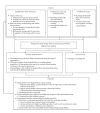Dealing with a Latent Danger: Parents Communicating with Their Children about Smoking
- PMID: 22792452
- PMCID: PMC3390106
- DOI: 10.1155/2012/382075
Dealing with a Latent Danger: Parents Communicating with Their Children about Smoking
Abstract
The purpose of this study was to understand parental approach to the topic of smoking with school-age preadolescent children. In-depth interviews were conducted with 38 parents and yielded a grounded theory that explains how parents communicated with their children about smoking. Parents perceived smoking to be a latent danger for their children. To deter smoking from occurring they verbally interacted with their children on the topic and took action by having a no-smoking rule. There were three interaction approaches, which differed by style and method of interaction. Most parents interacted by discussing smoking with their children. They intentionally took advantage of opportunities. Some interacted by telling their children about the health effects of smoking and their opposition to it. They responded on the spur-of-the-moment if their attention was drawn to the issue by external cues. A few interacted by acknowledging to their children the negative effects of smoking. They responded only when their children brought it up. The parents' intent for the no-smoking rule, which pertained mainly to their homes and vehicles, was to protect their children from second-hand smoke and limit exposure to smoking. The theory can be used by nurses to guide interventions with parents about youth smoking prevention.
Figures

Similar articles
-
Experiences and views of parents on the prevention of second-hand smoke exposure in Middle Eastern countries: a qualitative systematic review.JBI Evid Synth. 2022 Aug 1;20(8):1969-2000. doi: 10.11124/JBIES-21-00222. JBI Evid Synth. 2022. PMID: 35971199
-
Family attitudes about tobacco smoke exposure of young children at home.MCN Am J Matern Child Nurs. 2007 May-Jun;32(3):178-83. doi: 10.1097/01.NMC.0000269568.17432.72. MCN Am J Matern Child Nurs. 2007. PMID: 17479055
-
Parental attitudes towards the uptake of smoking by children.Health Promot J Austr. 2006 Aug;17(2):128-33. doi: 10.1071/he06128. Health Promot J Austr. 2006. PMID: 16916316
-
Perceptions of parental smoking and sociodemographic factors associated with the adoption of home smoking bans among parents of school-aged children.Nicotine Tob Res. 2014 Aug;16(8):1112-20. doi: 10.1093/ntr/ntu043. Epub 2014 Apr 1. Nicotine Tob Res. 2014. PMID: 24692672
-
Parental health risk perceptions and preventive measures related to Children's second-hand cigarette smoke exposure in Malaysia.BMC Public Health. 2021 Oct 15;21(1):1860. doi: 10.1186/s12889-021-11825-2. BMC Public Health. 2021. PMID: 34654405 Free PMC article.
Cited by
-
Smokers who have children with asthma: Perceptions about child secondhand smoke exposure and tobacco use initiation and parental willingness to participate in child-focused tobacco interventions.J Asthma. 2018 Apr;55(4):373-384. doi: 10.1080/02770903.2017.1339797. Epub 2017 Sep 6. J Asthma. 2018. PMID: 28759279 Free PMC article.
References
-
- World Health Organization. WHO Report on the Global Tobacco Epidemic 2011: Warning about the Dangers of Tobacco. Geneva, Switzerland: 2011.
-
- U. S. Department of Health and Human Services. How Tobacco Smoke Causes Disease: The Biology and Behavioral Basis for Smoking-Attributable Disease—A Report of the Surgeon General, Atlanta, Ga, USA, 2010, http://www.surgeongeneral.gov/library/reports/tobaccosmoke/full_report.pdf. - PubMed
-
- DiFranza JR, Savageau JA, Fletcher K, et al. Symptoms of tobacco dependence after brief intermittent use: the development and assessment of nicotine dependence in youth-2 study. Archives of Pediatrics and Adolescent Medicine. 2007;161(7):704–710. - PubMed
-
- The National Center on Addiction and Substance Abuse (CASA) at Columbia University. Tobacco: The Smoking Gun, New York, NY, USA, 2007, http://www.casacolumbia.org/absolutenm/templates/PressReleases.aspx?arti....
LinkOut - more resources
Full Text Sources

